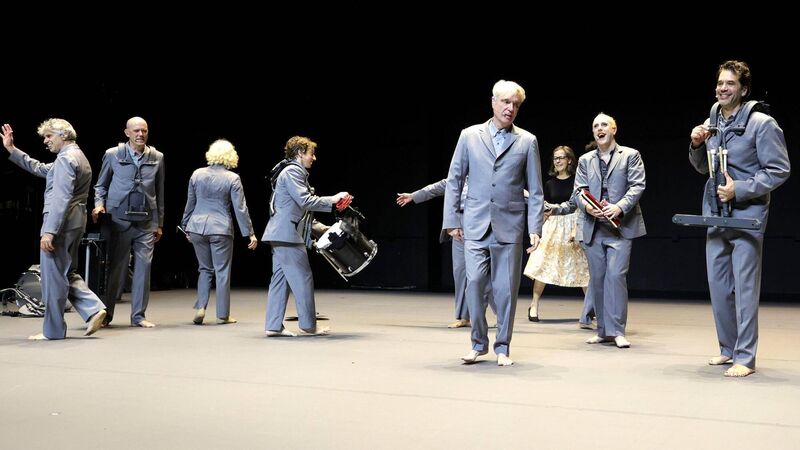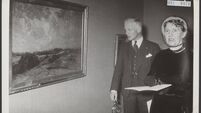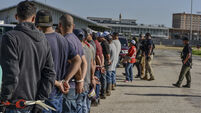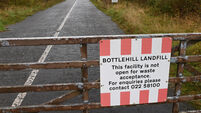Maeve Higgins: Me, a statue, was so moved that I danced my way to utopia

David Byrne performs during 'American Utopia' reopening night at St James Theatre in New York City. Picture: Jamie McCarthy/Getty Images
I am whatever the opposite of a dancer is. A statue, perhaps? I’m quite a still person, I know that much. But today, from time to time, and in the least likely of places, I feel a little dance coming on.
What is this impulse to move? Last month, I saw , David Byrne’s Broadway show, featuring the man himself and his catalogue of hits, accompanied by percussionists, singers, and musicians. They were in bare feet and grey business suits, choreographed by Annie-B Parson into a truly stunning show.
It feels like a marching band, a contemporary ballet, a rock show, and a West African shindig all happening at once.
I was there as an audience member, an observer, committed to the unspoken contract that I would watch from my seat and enjoy the show politely. I imagined a big clap at the end, the most physical reaction I would muster. Instead, I found myself leaping out of that seat and dancing my heart out along with the real dancers on stage!
I had to know what alchemy occurred to get a bunch of New Yorkers and tourists to move in ways we usually wouldn’t, in public, with such joy.
One obvious answer is that towards the end of the show, Byrne told us we could dance if we wanted to as long as we didn’t block the aisles. Permission felt important, but there was more to it than that. The divide between us and the cast seemed to close in those moments as we all danced together.
I spoke to one of the cast, the vocalist and dancer Tendayi Kuumba, and asked what that felt like from her perspective when we all started to dance.
Movement is a language, but it doesn’t feel like one I can speak. Using a lexicon more familiar to me, plain old English words, Kuumba explains that I don’t need to worry, because movement is innate.
“Before we can talk, we move. Before we can speak words, we yell, we holler, we cry.”
She tells me about movement as a person’s mother tongue, citing Jawole Willa Jo Zollar as a proponent of that idea. A 2021 MacArthur Fellow, Jawole Willa Jo Zollar is revered in the dance world for forming the Urban Bush Women — a performance ensemble dedicated to exploring the use of cultural expression as a catalyst for social change in 1984.

Kuumba, who was part of that ensemble for many years and still works with them, explains movement as our mother tongue this way: “Like how you started dancing with your mom in the kitchen, or where you’re making a little dance with your cousin.”
This mother tongue happens without any instruction and before any formal training, and is something she urges dancers to keep a hold of.
“How you’re digging into that mother tongue when you’re the most relaxed, the most comfortable, the most connected to whatever your home space is — whatever is coming up out of your body is organically you. And I think it’s important to remember to bring that with you when you go into whatever movement class you’re in, because you want to be able to have fun.
We do indeed, and aside from the extraordinary talent on display, there was something else to admire about — that was the sincerity and the refusal to budge from the high-minded aspirations of the title.
Throughout the music and dancing, there are messages about the importance of voting and the desperate injustice of police brutality against, in particular, black people. Byrne tells us he is an immigrant, brought over from Scotland as a baby. Many other members of the cast and crew come from abroad also. Surely, too, do the audience.
Migration and cosmopolitanism threaded seamlessly through the sounds and the people on stage. Like so many art forms, dance is co-opted and commodified, often to an extreme extent. The origins and truth of the movements are, deliberately or mistakenly, obscured to make somebody rich or famous, if only for a moment, if only for social media.
That does not happen in , although it is a kaleidoscope of movements that come from all across the world. There is a difference between cultural appreciation and cultural appropriation — something Tendayi Kuumba discusses.
“I think it’s important to hold on to the history that’s connected with it, whether you know a smidgen of it or, you know, the whole pie. I think it’s important to continue to keep that alive, too. That’s beautiful, and I think that’ll help keep pushing where movement can go, where it exists, where it lives, and what stages it lives on.”
A highlight of the show happens during the song ‘Toe Jam’, when Kuumba does a solo dance — a traditional West African dance called a ‘kuku’. Choreographer Annie-B Parson saw Kuumba perform a kuku at a different show and incorporated it. This created a gorgeous moment within the larger show and also something meaningful for the dancer and the dance — “being able to represent that in that solo moment felt kind of just like a moment of me being able to bring peace to my community”.
There is a filmed version of on HBO if you can’t make it to Broadway. It’s beautiful and lots of fun to watch, and surely nobody will tell you to sit down when you’re dancing in your own home.
You will recall that during our conversation, Tendayi Kuumba was adamant that movement is for everyone. Here is one of the most compelling dancers and vocalists I’ve ever seen telling us that movement is actually for everyone.
Perhaps I’ll take dance class this week or go to a bar with a DJ tonight; they’re still a thing, right?
The pandemic is also very much still a thing, of course. So maybe I’ll just put a grey blazer and some music on and jerkily spin around my bedroom until I stop thinking and feel something again.













